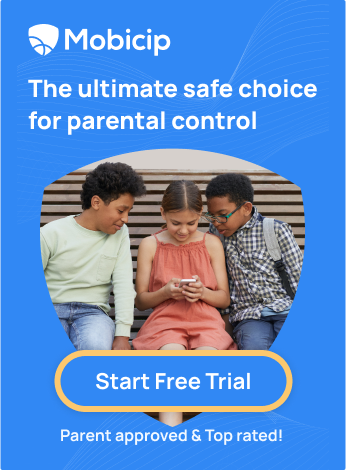How to Spot Social Media Addiction in Kids: A Guide for Parents

Hey there! Ever caught your teenager glued to their phone and shook your head, thinking, "Kids these days?" But what if there's more going on? What if it's not so simple? What if your child is struggling with something serious, like being hooked on something stronger than we realize?
We all know social media is more than a problem for young people. Just take a quick scroll, and you'll see folks from as young as a baby to an elderly granny showcasing their talents, daily lives, and thoughts. Suddenly, you've spent an hour without even budging.
So, before we dismiss the younger generation's obsession with social media as a lack of self-control, let's dig deeper. Let's figure out why it affects us all so much and see if we can do anything about it.
What Is Social Media Addiction?
Simply put, Social Media Addiction is an overwhelming urge to use or check our accounts and feeds on social media sites like Facebook, Instagram, Twitter, Snapchat, TikTok and so on. People who struggle with this addiction are apprehensive about missing out on the latest stuff (they call it FOMO), so they spend a lot of time on these sites. It can be seen as a compulsion or a behavioral addiction where an individual becomes dependent on a certain activity or action.
According to research from Common Sense, teens average 7 hours and 22 minutes of screen time per day, and kids 8–12 years old get an average of 4 hours and 44 minutes of screen time per day. Also, research from San Diego State University revealed that 7 in 10 teens who use social media for over 5 hours are at higher risk of committing suicide.
Social Media addiction causes negative psychological and physical symptoms in individuals of all ages. What makes it particularly potent on younger individuals, whose brains are still developing, is that Social Media can reinforce addictive behaviors and make our youngsters dependent on instant rewards.
The Role of Dopamine in Social Media Addiction
"Social media platforms drive surges of dopamine to the brain to keep consumers coming back over and over again. The shares, likes and comments on these platforms trigger the brain, resulting in a "high" similar to the one people feel when gambling or using drugs," says Dr. Nancy Deangelis, Director of Behavioral Health, Jefferson Health, Abington. Dopamine is a neurotransmitter that creates pleasure and works in the brain's reward centre. The need to recreate that dopamine rush can trap our children into making more and more posts and spending more time on social media.
Psychologists also believe that the consistent focus on oneself caused by social media can lead to a paradoxical fall in self-esteem. Low self-esteem, in turn, can lead to a plethora of mental health challenges like Depression, Eating Disorders, Substance Abuse and Self Harm. A 2019 study suggested that teenagers who used social media for more than 3 hours a day were more likely to experience anxiety, aggression and antisocial behavior. Reduced sleep quality and impaired decision-making have also been seen in young people who are heavy social media users.
Signs and Symptoms of Social Media Addiction
Looking for signs of Social Media Addiction in your child can be a tricky task. The most challenging part is answering the question, "How much is too much?" More often than not, a teen who is addicted to social media is facing the brunt of the addiction themselves.
Consider starting with online tests to assess the issue. Keep in mind, these tests are not diagnostic but can help gauge the problem's severity. Collaborate with your child to find solutions based on the results. If the addiction appears severe and affects their well-being, seek support from mental health professionals.
Parents need to step up, too. We've seen too many cases where kids suffered because their social media use got out of hand. By keeping an eye out for warning signs early on and setting clear rules, we can help prevent a lot of pain down the road. Talk openly with your kids about their online habits and be there to support them. It could make all the difference.
Here are some signs that you can keep an eye out for as a supportive parent:
-
Spending a significant amount of time on Social Media
Considering social media's prevalence and popularity, it can clearly be seen to have users hooked for long periods of time. Now, it is possible that your youngster might not be glued to their phones all day, but if they're checking them constantly every few hours, that's a sign, too.

A survey by Gallup asked over 1,500 American teens about their social media habits. They found that more than half of these teens, about 51%, spend at least four hours every day on social media apps like YouTube, TikTok, Instagram, Facebook, and X.
Experts say it's best to limit leisure screen time, like social media, to less than 2 hours a day. Anything more than that might be too much. So, it's worth keeping tabs on how much time our kids spend scrolling through those apps.
-
Social media usage is getting in the way of other areas of life, such as school, relationships, etc.
We've probably all seen it: our kids let their social media time eat into the time they should be spending on other vital things like studies, chores, personal hygiene, time with family, and sleep. It's a big red flag for addiction because it shows they can't stop themselves, even when they know they should.
When it gets really bad, some kids even start avoiding things they used to enjoy so that they can spend more time on social media. It's like they're hooked and can't break away, even if it means missing out on other important parts of life.
-
Increase in negative emotions like anxiety or irritability
This is akin to withdrawal symptoms, which are indicative of addictive patterns. Think of it like this: when your child does not have access to social media when they want to, do they express negative emotions? That could mean they're too attached to social media apps. They may be worried about what their friends are doing or want to feel accepted online. If they're getting really stressed out or grumpy when they can't use social media, that's a sign of a bigger problem.
-
Using Social Media as an escape methodology
Have you noticed if your kid starts doom-scrolling through their phone when things get awkward or uncomfortable? That could mean they're using social media as a way to cope with difficult feelings. They're trying to distract themselves from what's happening by diving into their apps. That's not a healthy way to deal with stuff, and it could be a sign they're too dependent on social media.
Setting Healthy Boundaries on Social Media Use
It's important for us parents to pay attention to and protect our kids, but it's even better when we work together with them to manage their digital lives. Discuss and agree on boundaries for your child's social media usage. "Do not exasperate your children" is a good rule of thumb. Your child can feel frustrated if they sense you do not trust them with their social media usage. Find a balance and help them see that your supervision comes from a place of concern, not a lack of trust.
Here are some healthy boundaries to keep our kids from getting too wrapped up in social media:
1.Age Limit: Determine an appropriate age for when your child can start using social media platforms. Many platforms have age restrictions, and it's generally recommended to wait until at least 13 years old, as per COPPA (Children's Online Privacy Protection Act) guidelines.
2. Screen time limits: Work together with your child to decide how much time they can spend on their devices and social media each day. It's important not to go cold turkey on social media unless it's really necessary. Instead, try finding other fun things to do together as a family, like playing outside or spending time in nature. These can give them the same dopamine highs without relying too much on their phones.
3. Limiting devices: Consider how many devices your child really needs. You might want to agree to let them use only certain devices for social media, which can help them avoid spending too much time on it without thinking.
4. Device-free zones: Choose spots in your home, like the dinner table or bedroom, where phones and tablets aren't allowed. Making this rule for everyone in the family, including grown-ups, can show your child that using devices responsibly is important for everyone.
5. Designated Times: Establish specific times when social media usage is allowed. For example, no social media during family meals, before bedtime, or during homework/study time.
Educating Kids About Social Media Use
Here are some tips on educating our kids about using social media safely and responsibly.
1. Start Early: Teaching kids about online safety and responsible social media use is never too early. As soon as they start using digital devices, talk to them about privacy, sharing, and how to behave online.
2. Learn Together: It can be really helpful for both you and your child to explore social media together. Check out the apps and features that interest them and talk about what's good and not so good about spending time on them. This helps your child understand their own preferences and needs so they can be more responsible with their social media use.
3. Talk Openly: Make sure your child knows they can come to you with anything that happens online, even if it's embarrassing or difficult. Create a safe space for them to talk about their experiences, process their feelings, and take action if needed.
4. Set Clear Rules: Make sure your child knows the consequences of breaking social media rules, like losing privileges or having more parental supervision. This will help them understand the importance of using social media responsibly.
5. Discuss Risks: Have age-appropriate conversations about the risks of social media, like cyberbullying, online predators, scams, and seeing things they shouldn't. Help your child recognize these risks and what to do if they encounter them.
Monitoring Apps and Parental Controls
Did you know that social media apps have built-in tools to help keep our kids safe online? For example, TikTok has 'Digital Well-being' festure that lets you set limits on how long your child can spend on the app. Instagram also has a feature called 'Supervision' that lets you see what your child is doing on the app, but you can't control anything with it. Facebook's tool is called 'Your time on Facebook' that limits your child's time spent on facebook. But these built-in tools can be pretty basic.
That's where Mobicip comes in! It's a super-powered tool for monitoring our kids' online activities. It's a parental control app trusted by many parents like us. With Mobicip, we can do a lot more to ensure our kids are safe and using their devices responsibly.
Screen time Scheduler: You can decide when your child can go online and when they can't. So, during school time, homework time, or when it's time to sleep, you can make sure they're not using their devices.

Social Media Monitor: Mobicip looks at what your child does on popular social media apps like Instagram, Facebook, and Snapchat. If it finds anything that could be harmful, like bullying or scary stuff, it tells you right away so you can help.

Limit App Usage: You can decide how long your child can spend on social media apps and other apps, too, so they don't spend too much time on their phones or tablets.
App Blocker: Social media apps can be addictive and distract kids from living productive lives. With Mobicip, you can block those apps so your child can focus on important things like homework or playing outside.

These features help you keep your child safe and balanced when they're using their devices. You can start a 7 day free trial and experience the benifits of Mobicip firsthand.
FAQs
Is social media addiction a recognized disorder?
According to the DSM-5, social media addiction is not a recognized medical condition. The American Psychiatric Association (APA) lists only Internet gaming disorder (or video game addiction) as a "condition requiring further study".Social Media has, however, shown a highly addictive nature and is being studied in detail by several mental health professionals.
How can I talk to my child about social media addiction?
Here are some simple tips for creating a safe and open space to discuss social media addiction and usage:
- Talk to them often about what they do online. Start the conversation early, so they learn to be comfortable with device interactions.
- Be open about your experiences with social media's effects on you. Your child might reciprocate your honesty and openness.
- Give them the space to voice their opinions or differing points of view. Try to be reasonable with them.
What if my child resists boundaries?
Start small, focus on areas you can agree on for the need for boundaries, and then, in time, work towards the tougher ones. Keep revisiting the topics that you need help finding common ground on. Request them to do their research into those areas while you do the same so that you can have further conversations on it. Remember that it is their well-being you want to preserve. Driving them to points of frustration might be counterproductive, especially if it makes them secretive about their social media usage. It will also go a long way with your youngster when you model responsible social media usage.






